#Best potting mix for indoor plants
Explore tagged Tumblr posts
Text
Best indoor potting mix-Falaj Garden Enhance your hydroponic garden with top-quality agricultural grow lights, perfect for growing lettuce and other plants. These lights provide the ideal spectrum to boost plant growth, ensuring healthy yields in your nutrient film hydroponic system. Optimize your indoor garden with the best potting mix for indoor plants and enjoy fresh, homegrown lettuce year-round. https://falajgarden.com/product-category/potting-mediums/potting-mix/

#Best nutrients for NFT systems#Nutrient film hydroponic system#Best Potting mix home depot#Best indoor potting mix#Best potting mix for indoor plants
0 notes
Text
Choosing the Right Potting Mix for Your Indoor Plants: A Comprehensive Guide – Nathancoir
Selecting the Proper Potting Mix:-
The key to selecting the best indoor potting soil mix, such as potting soil for indoor plants, is to choose the right potting mix. It guarantees the optimal growing conditions for your plants. Considerations need to be made for things like drainage, moisture retention, and plant-specific needs. Bright, healthy indoor vegetation starts with the right potting mix.
Understanding the specific needs of your indoor plants:-
The first step in starting a successful indoor gardening project is understanding the particular requirements of your indoor plants. Diverse species have different needs with regard to the makeup of the soil. Some prefer soil that drains readily, while others do well with moisture retention. Understanding these particular requirements will help you select the ideal potting mix to promote their development and vitality.
#potting soil for indoor plants#best indoor potting soil mix#best organic potting mix for indoor plants
0 notes
Text
Pretty Pink Plants

(Disclaimer- I'm not a professional gardener, these are just some plants I thought were pretty and researched slightly. If you're looking into becoming a plant parent then I recommend you research these plants some more.)

Calla Lillies
Calla Lillies can live both indoors and out. For them to prosper inside, they must be potted in moist soil and kept in rooms that range from 60-80 degrees Fahrenheit, along with being exposed to a decent amount of light.

String of Hearts
String of hearts is an easy plant to grow indoors and serves as a cute plant you can hang or place on shelves, and they can also be propagated.

Polka dot Plants
Polka dot Plants thrive both indoors and outdoors, growing best in rich soil and indirect amounts of sunlight. Similarly to the String of Hearts, it too can be propagated.

Pink Lilies
Pink Lilies can survive both inside and out. They prefer humid environments and need to be watered about once a week.

Tulips
With the proper care, tulips can grow indoors, in fact they can be grown in glass vases. The plant most commonly kept outdoors live best in a sunny yet cool room, and if potted should be watered 2 to 3 times a week to keep the soil moist.

Fuchsias
Though Fuchsia’s are mostly outdoor hanging plants, ideal for deck and porches, they can be grown inside with proper moister and indirect sunlight and can serve as a lovely way to liven up a room.

Pink Princess Philodendrons
Pink Princess Philodendrons can be grown indoors and more commonly thrive in humility and indirect light. The plant can easily be propagated.

Calathea White Stars
Calathea White Stars prefer indirect sunlight and can live in tropical environments and indoors. It's somewhat difficult to grow, most commonly requiring a draining soil mix and can propagate as well.

Peonies
Peonies can live indoors, serving as a cute decoration in any room although they require about 5 to 6 hours of sunlight daily, so remember to keep them in a sunny room.

Astilbe
Astilbes can be grown indoors and outdoors, but if you consider growing them indoors, place them in a spot where they can get about 4 to six hours of sunlight daily.
#girlblogging#girlhood#pink#i’m just a girl#pink aesthetic#pink blog#pastel pink#that girl#just girly posts#just girly things
22 notes
·
View notes
Text
Native Gardening: A Guide for Cold Stratification
It's nearly January, which means that it's time for me to start stratification for my native seeds.
Many native seeds have a built-in dormancy mechanism which will prevent germination until it is broken either naturally by weather, or artificially via cold/moist stratification in the refrigerator. This is a guide for the refrigeration method.
It's best done about 2-3 months before spring if you plan on starting the seeds indoors, or 2-3 months before your last frost date if sowing outdoors (depending on germination requirements). This year I'm using peat moss but you can substitute it with moist sand or damp paper towels.
Choosing Your Plants
One thing to consider before buying native seeds is how successful they will be once planted in your garden. The best way to determine this is by going outside and seeing what grows naturally in the yard.
For example, my yard has mostly shade-loving plants like the Common Blue Violet, Bloodroot, and Witchgrass, along with some hardier, more tolerant species like Blue Wood-Aster and Common Milkweed. Sun-loving plants like goldenrod are present but restricted to the edges of the property. Despite having no natural water source, I have seen a few water-dwelling species pop up as well.
This means that I have a pretty moist/shady backyard and that I should focus on species that either prefer these conditions or are very tolerant of them.
Remember to choose species that grow naturally in your biosphere. Some native seed vendors will provide range maps which will show you where certain plants exist in the wild. This is important because the entire point of native gardening is to support your local ecology and wildlife.
This year I'm raising Virginia Strawberry, Early Goldenrod, Sundial Lupine, Columbine, Spotted-Touch-Me-Not, Bloodroot, and Highbush Cranberry. In addition to pollinators like bees, wasps. and butterflies, these plants will be beneficial to songbirds, hummingbirds, and small mammals.
I always buy seeds from Prairie Moon Nursery. I've had great experiences with them and they even offer native range maps and germination instructions for each species.
Materials:

One bag of peat moss
A mixing bowl
A pitcher or measuring cup of water
Lidded jars or sealable plastic bags (1 per species)
A permanent marker and painters tape for labels.
Seeds of your choosing
Instructions:
Fill your mixing bowl with peat moss.
Slowly add water and mix with your hands until the moss is moist but not soaked. You should be able to form it into a ball.
Press peat moss into each container.
Sprinkle in the seeds. I covered the larger seeds with more peat moss, but the smaller seeds were just sprinkled on top so that I can actually find them when it's time to plant.
Seal containers and label each with the species name, length of time required in the fridge, (usually 60-90 days), and if it requires double dormancy.***
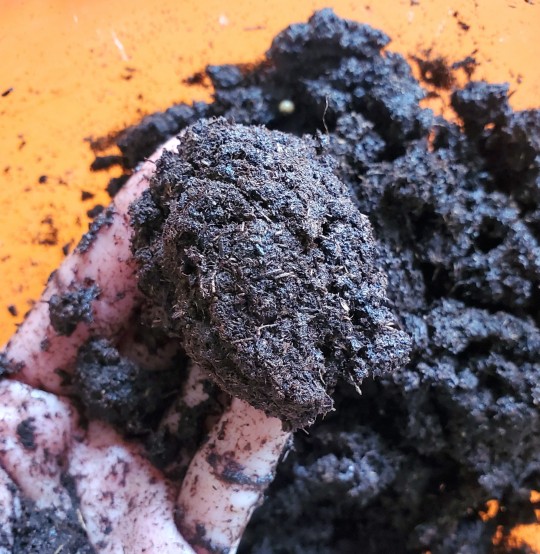



After this, place the containers in the fridge for 60-90 days, depending on the germination requirements. You should check on them weekly to make sure they don't dry out or grow mold. If a seed starts sprouting during stratification, remove it from the container and plant it in a starter pot.
After the 60-90 day period, the seeds will be ready to germinate. Move them into starter pots with soil or plant them directly into your garden bed.
I prefer starting my plants in Peat Pots, which are compostable and can be planted directly in the ground. This allows me to raise my seedlings indoors without the threat of wildlife or competition while preventing me from disturbing their root system when transplanting.
***Note on Double Dormancy
Some plants have double dormancy requirements for germination and can be more challenging to grow. This means that the plant will need a period of cold moisture, then warm moisture, and finally another period of cold moisture before they will germinate. Bloodroot, American Cranberrybush, and Spotted-Touch-Me-Not are all species that need double dormancy.
8 notes
·
View notes
Text


⠀⠀⠀⠀⠀ 𝑁𝑎𝑛𝑎𝑚𝑖𝑛 headcanons .ᐟ ⠀⠀⠀⠀⠀⠀⠀⠀ mr autism feat. his antics
content: sfw wc: 623
a/n: look, i know there is a small minority of us in the jjk fandom that believes nanami kento is autistic, so this post won't appeal to the masses. if you don't like this, nor agree with it, that's fine (that's why fanon and au's are cool). just don't be a dickhead and leave mean comments. also, this was co-written by my beloved sibling @lesbian-choso. go check out his blog; they make lovely traditional art.
banner credits:⠀@/dollienini + @/chilumitos

Flat affect — no explanation needed.
Stims: jiggling his watch, cracking his knuckles and other joints, pacing around.
This man cannot stand loud noises, though controlled loud sounds, like listening to his screamo playlist, is totally fine.
I firmly believe he sleeps like a dead person at an open-casket funeral. His bed sheet is in a straight line across his chest, with his arms lying flat on either side of his torso — Back Sleeper™️. Best believe he can't sleep unless his room is 18°C, with his bedsheets and duvet even on each side of the bed, and a fresh bottle of water on his bedside table (in case he wakes up and feels parched).
Whilst he isn't a fan of journals and diaries, Kento makes sure to regularly update his calendar on his phone, as well as the one attached to Outlook.
Spreadsheets and to-do lists, he thrives off of these. How else is he to keep up with life?
He is very aware of the fabrics and textures that make contact with his skin. This is why his wardrobe is predominantly made up of soft materials like cotton and cashmere. If he has to wear anything woollen, a lightweight layer of clothing goes underneath; he can't stand the itchiness.
Kento doesn't like mixing cold and warm food, and he tries his best to keep the food on his plate from touching each other (this doesn't apply to food like fried rice).
He irons his bedsheets and underwear — don’t ask. Kento also regularly washes his curtains and steams them once they’re dry (no creases, he hates them).
Exclusively purchases one type of deodorant; it has something to do with the smell and texture. He can’t stand aerosols because of the intensity of their smell (it gets into the back of his throat), and the gel deodorants feel uncomfortable on his underarms. Kento also isn’t a fan of perfume, though, there was one he liked that he stocked up on. Sadly, he hasn’t been able to find anything similar.
“Don’t come in the kitchen whilst I'm cooking.” — Kento to Satoru when he senses him about to step in. He can't share the space, it becomes claustrophobic.
Baking is his special interest; he has an absurd amount of information about this art form stored in his noggin. Dare I say he would own a bread encyclopaedia if it existed. Whilst bread is his favourite form of baked good, from time to time, he attempts to make confectionary, specifically those made of phyllo pastry. On the rare occasion, he might bake a pie or cake.
This man owns a lint roller because of his pet cats; he is not a first-time cat owner. Whilst his home is relatively clean, he can't help but feel the need to pick up those stray cat hairs. He doesn't want to accidentally get any in his mouth.
Speaking of his home, Kento's apartment is relatively minimalist, though the colour palette is warm and welcoming (lots of blues and browns). The only part of his home that is “messy” is one nook in his living room. The bookcase is overflowing with unread books, some sitting in neat stacks on the floor, whilst others are in cardboard boxes acting as surfaces for his potted plants. There are a few old newspapers and magazine recipes strewn on his desk, a cold cup of coffee, and two pen holders jam-packed with various dry markers and inkless pens. It's a sort of organised chaos.
He exclusively wears slippers and thongs/flip-flops indoors. He can’t stand walking around barefoot, it’s uncomfortable, and he doesn’t like his feet being cold or picking up any hair, lint, or crumbs that collect on the floor (despite his home being borderline sterile).


© 𝑘𝑒𝑛𝑡𝑜𝑠𝑑𝑜𝑙𝑙⠀ ─⠀ all rights reserved. seek inspiration, do not copy, translate, or redistribute my writing/content.⠀₊˚ෆ
#jujutsu kaisen headcanons#jujutsu kaisen hcs#jjk headcanons#nanami kento fluff#nanami kento headcanons#nanami kento hcs#kento nanami headcanons#kento nanami hcs#nanami kento drabble#kento nanami drabble
50 notes
·
View notes
Text

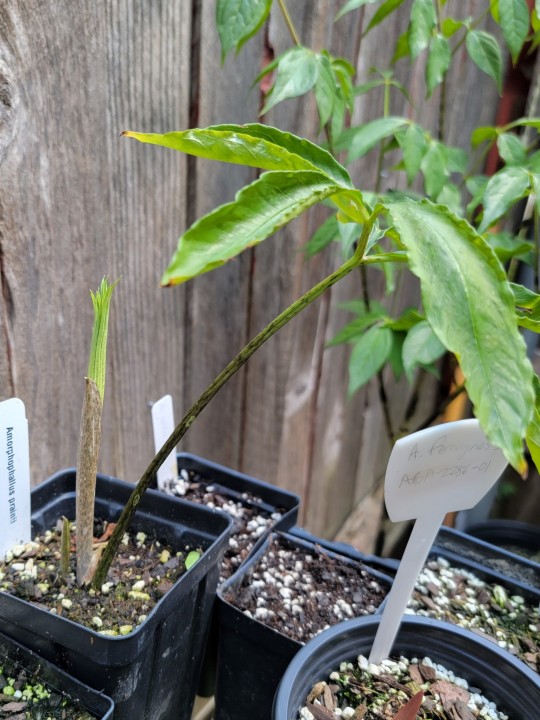
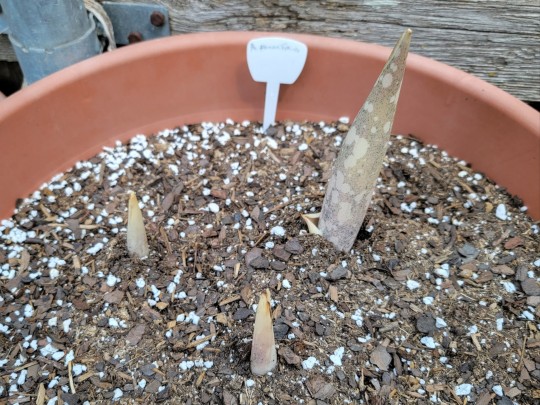
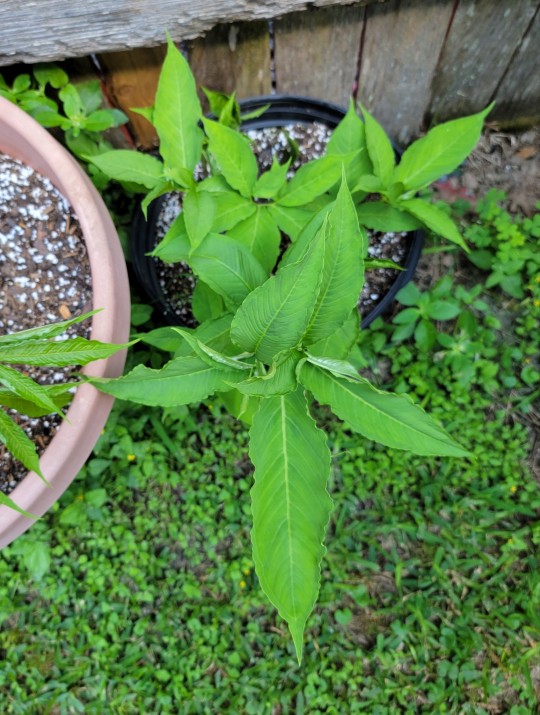


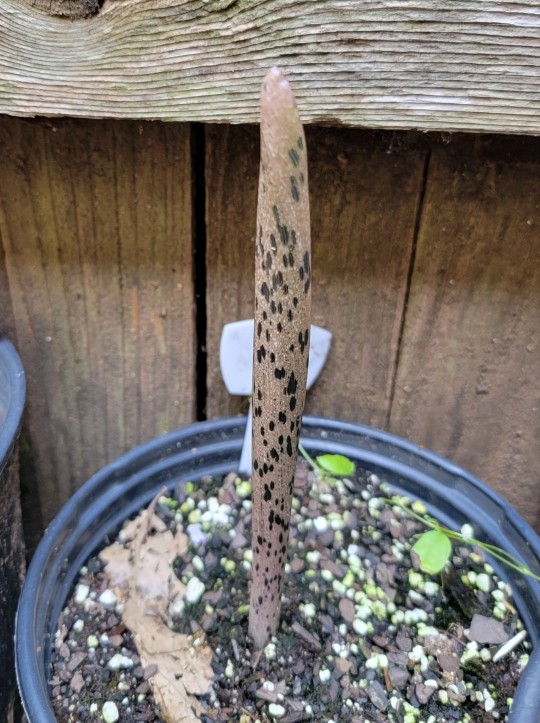
Amorphophallus (and similar tuberous aroids) incoming!
In past years, I've thrown the corms I've had in a couple of large pots and called it a day. While this is the most convenient way to do it, it causes some cultural problems. Not all species emerge from dormancy at the same time or rate*, and the same is true going into dormancy. This means some corms are at risk of rotting if you water the actively growing plants.
Complicating this further is the fact that amorphophallus can be broadly divided into two groups. Some species, specifically the more cold hardy ones like konjac, paeoniifolius and bulbifer, follow a pretty regular schedule; they begin to emerge from dormancy around March or April, and can be potted up by May or June. They go dormant as days shorten and cool in the autumn, and their corms can be dug up for storage in a cool, dry place until temperatures warm.
Other species, like titanum, don't necessarily follow this seasonal pattern. They may go dormant in response to factors like a change in environmental conditions (e.g., being brought indoors for winter) or being left dry too long. They may not go dormant at all some years, in optimal conditions. Their dormancies are usually significantly shorter too, and they will not tolerate much cold. This means they need more attention throughout the year, and should be left potted when dormant, because they do best with a little water here and there. Some non-amorphophallus like Anchomanes and Gonatopus also require this treatment. There's a more extensive article on this here, but long story short, you need to know which is which.
I have not been mixing the two groups, but having obtained a number of new species recently, I decided it was finally time to get rid of the community pot approach to reduce potential losses overall. Most of the big corms actually lost some mass in last year's extreme heat and drought, so this will hopefully allow me to better control conditions and speed up their recovery. The downside? So many fucking pots. So many smaller pots, too. Time to find some new outdoor shelving.
*This is a callout post for Sauromatum giganteum particularly, forever the kid who sleeps through their 8AM classes
42 notes
·
View notes
Text
BEST BALCONY INTERIOR DESIGN- Avivakeeon Interio
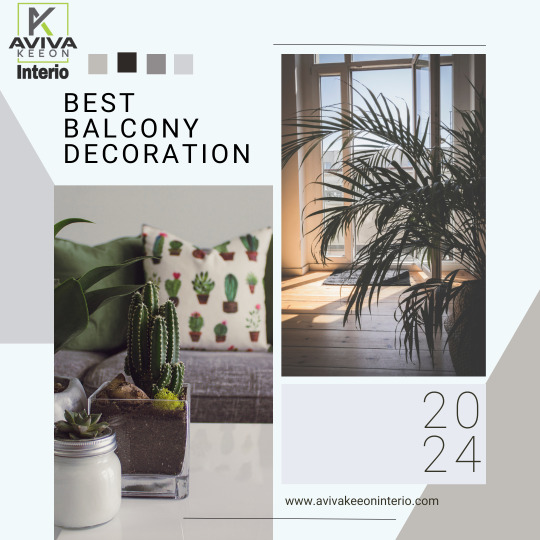
Beautiful Balcony Decoration Inspirations with Avivakeeon Interio
Introduction to Balcony Decoration with Avivakeeon Interio
In today's fast-paced world, a well-decorated balcony serves as a serene oasis, offering a tranquil escape from the hustle and bustle of daily life. Avivakeeon Interio understands the essence of transforming these overlooked spaces into stunning outdoor retreats. With their expertise in home design, they provide an array of creative balcony decor ideas that blend aesthetics with functionality. Whether you have a sprawling terrace or a compact balcony, Avivakeeon Interio has the perfect solution to enhance your outdoor decor, creating a harmonious extension of your indoor living space.
Maximizing Small Balcony Spaces
In urban living, balconies often serve as the sole sanctuary for outdoor relaxation. It's essential to maximize their potential, especially when space is limited. With Avivakeeon Interio's expertise, transforming even the smallest of balconies into functional and stylish retreats is attainable. Here, we'll explore some clever strategies for maximizing the use of small spaces.
Choosing Foldable Furniture
One of the most effective ways to optimize a small balcony is through the use of foldable furniture. These flexible pieces are perfect for compact spaces as they offer a dual advantage — fashion and functionality.Avivakeeon Interio offers a range of chic and space-saving foldable chairs, tables, and loungers that can easily be stashed away when not in use, granting the illusion of more space.
- Foldable Bistro Sets: Ideal for intimate dining, these sets provide a quick escape for morning coffee or a serene spot for dinner at dusk.
- Foldable Hammocks: Designed for relaxation, these can be swiftly set up when you wish to unwind and folded away when entertaining guests.
- Multi-tier Plant Stands: These not only serve as aesthetic pieces but also as practical solutions for vertical gardening, contributing to an organized outdoor environment.
Vertical Gardening Techniques
Vertical gardening is an innovative technique that helps utilize every inch of balcony space, transforming even the smallest balconies into green havens. Avivakeeon Interio embraces this concept by offering modular vertical planters that add both greenery and artistic allure to your space.
- Wall-mounted Planters: These are perfect for planting herbs, succulents, or small flowering plants, saving floor space while enhancing the natural charm of the balcony.
- Hanging Pots and Baskets: Add layers and levels to your balcony’s flora with hanging planters that create a cascade of colors and textures at eye level.
- Trellises and Climbers: Consider installing a trellis for climbing plants such as ivy or jasmine to create a lush, natural privacy screen while adding depth to the design.
Utilizing Outdoor Rugs for Style
Outdoor rugs are a simple yet effective tool to define space, inject color, and add warmth to a balcony area. Select patterns and textures that reflect your style while blending effortlessly with other decor elements. Avivakeeon Interio’s collection of weather-resistant outdoor rugs comes in diverse colors and designs that can withstand elements while offering a plush feel underfoot.
- Zoned Areas: Use rugs to demarcate different functional zones—dining, lounging, and gardening—to make your balcony feel more structured and spacious.
- Texture & Pattern Play: Mix and match textures and prints to create an eclectic vibe or stick to a uniform color palette for a more minimalist approach.
- Maintenance Tip: Opt for materials that resist fading and are easy to clean, ensuring your rug retains its vibrancy through the seasons.
Creating a Cozy Atmosphere
A balcony’s true potential is revealed when it becomes an inviting haven. Creating a cozy atmosphere goes beyond just maximizing space; it involves crafting an environment that feels warm, inviting, and uniquely yours. Explore Avivakeeon Interio’s recommendations for designing an enchanting outdoor retreat.
Incorporating Soft Lighting Solutions
One key element in shaping a cozy ambiance is the use of soft, ambient lighting. Avivakeeon Interio provides a plethora of lighting solutions that can transform your balcony after dusk.
- String Lights: Drape these along railings or overhead to infuse a gentle glow that suggests warmth and intimacy.
- Lanterns & Candles: These provide an alluring, flickering charm perfect for evening relaxation or late-night conversations.
- Solar-powered Lights: A green alternative that minimizes wires while providing sustainable illumination, especially handy for balconies lacking electrical outlets.
Selecting Comfortable Seating
Seating is at the heart of any comfortable balcony setup. It's essential to choose seating that not only fits the space but also enhances relaxation. Avivakeeon Interio offers a vast selection of seating options designed to suit various preferences and styles.
- Cushioned Chairs and Sofas: Opt for weather-resistant cushions that not only promise comfort but also withstand the elements without compromising on aesthetics.
- Swing Chairs and Hammocks: These are excellent for those who desire a bit of leisurely sway while enjoying their balcony sanctuary.
- Customizable Modular Seating: Flexible arrangements allow for tailored configurations, easily adapting to your needs whether you’re hosting a gathering or enjoying solo downtime.
Adding Personal Touches with Accessories
An inviting balcony is a reflection of your personality, and the final touches should convey your style and interests. Avivakeeon Interio suggests a selection of accessories that imbue a personalized charm into your balcony space.
- Throw Pillows and Blankets: Introduce layers of comfort and pops of color that can be swapped out with the changing seasons or trends.
- Decorative Items: Incorporate elements like small sculptures, water features, or decorative pots that resonate with your tastes.
- Art and Wall Decor: Consider weatherproof art pieces or wall installations that adorn your space with character and flair.
Creating a beautiful balcony with Avivakeeon Interio means combining practicality with personal expression. Even the smallest spaces can be transformed into serene, scenic retreats with the right strategy and inspiration. Embrace these ideas to redefine your balcony into a beautifuloutdoor living extension of your home.
Incorporating Eco-Friendly Features
Creating a balcony space that is both stylish and environmentally conscious is a rewarding endeavor. Whether you're aiming to reduce carbon footprints or simply wish to bring the tranquility of nature into your home, incorporating eco-friendly features into your balcony can transform it into a serene oasis. Avivakeeon Interio offers stunning and sustainable design choices to enhance your outdoor retreat with minimal environmental impact.
Sustainable Materials for Decor
One of the first steps towards an eco-friendly balcony design is selecting sustainable materials. These materials not only minimize environmental damage but also lend a unique aesthetic to your space. Here are a few options to consider:
- Recycled Furniture: Opt for furniture made from recycled or upcycled materials. Pieces crafted from reclaimed wood, recycled aluminum, or recycled plastics are excellent choices. Not only are these materials environmentally responsible, but they also add a rustic, lived-in charm to your balcony.
- Natural Fibers: For textiles such as cushions and rugs, consider materials such as organic cotton, bamboo, or hemp. These fibers are biodegradable, renewable, and often require fewer resources to produce compared to conventional textiles.
- Sustainable Wood: If wood is your material of choice, look for certifications such as those from the Forest Stewardship Council (FSC), which ensure that the wood is sourced from responsibly managed forests.
- Eco-Friendly Lighting: Opt for solar-powered lights or energy-efficient LED bulbs. These options reduce energy consumption and blend beautifully with nighttime balcony settings, creating a warm and inviting glow.
Adopting these materials helps in promoting sustainability while maintaining a stylish and modern design for your balcony. Each selection conveys a commitment to eco-friendliness without sacrificing aesthetics.
Setting Up a Balcony Herb Garden
Another impactful way to incorporate eco-friendly elements into your balcony is by establishing a herb garden. Growing your own herbs not only provides a fresh supply of ingredients for your kitchen but also contributes to a greener lifestyle.
Here's how to create an efficient and thriving balcony herb garden:
- Choose the Right Containers: Select containers that fit your balcony space and allow for adequate drainage. Consider using terracotta pots, which are porous and help maintain moisture balance. Alternatively, recycled containers such as tin cans or old wooden boxes add a rustic touch and are a sustainability-friendly choice.
- Select the Ideal Herbs: Start with herbs that thrive in balcony conditions. Common choices include basil, mint, rosemary, chives, and parsley. These herbs are not only versatile but also forgiving, making them perfect for beginner gardeners.
- Optimize Sunlight and Watering: Most herbs prefer plenty of sunlight, so place your garden where it will receive sufficient light daily. Water the plants appropriately as per their needs—overwatering can be as harmful as neglecting them. Balconies with limited sun exposure can benefit from shade-tolerant herbs like mint or chives.
- Organic Care: To keep your herb garden thriving in an eco-friendly manner, consider organic fertilizers and pest control methods. Avoid harsh chemicals; instead, use compost tea or neem oil for a sustainable approach.
By integrating sustainable materials and cultivating a personal herb garden, your balcony becomes a relaxing retreat and a testament to eco-friendly living. Avivakeeon Interio’s balcony decor ideas not only foster ecological consciousness but also enhance the aesthetic allure of your outdoor space.
Conclusion
In conclusion, creating a stunning balcony space is more achievable than ever with the innovative designs offered by Avivakeeon Interio. Whether you're looking for a cozy nook with a few potted plants or a fully furnished outdoor extension of your living space, Avivakeeon Interio provides exquisite solutions that cater to all tastes and preferences. Harness the power of thoughtful design to transform your balcony into a functional and beautiful retreat that complements your home’s aesthetic. Remember, a well-decoratedbalcony not only enhances your home’s appeal but also offers a personal sanctuary where you can relax and unwind in style. Apply these design inspirations and breathe new life into your outdoor space today.
2 notes
·
View notes
Text
Herbs for Beginners: Growing and Using Fresh Herbs
Growing herbs is a rewarding and practical hobby that can enhance your cooking, improve your health, and add beauty to your home. Whether you have a sprawling garden or just a windowsill, herbs are relatively easy to grow and maintain. This guide is designed for beginners who want to explore the world of fresh herbs, offering tips on developing and creative ways to use them in your daily life.
Choosing the Right Herbs for Your Garden
If you're new to gardening, it's wise to start with hardy herbs that require minimal care. Some of the easiest herbs to grow include basil, mint, Parsley, chives, and oregano. These herbs thrive in various conditions and are forgiving if you occasionally forget to water them.
Basil is a versatile herb that grows well in warm, sunny conditions. It's a staple in many cuisines and can be used in everything from pesto to salads. Mint is another beginner-friendly herb that grows quickly and can even become invasive. Its refreshing flavor is perfect for teas, desserts, and garnishing dishes.
Whether curly or flat-leaf, Parsley is a biennial herb that can add a fresh, clean flavor to soups, sauces, and salads. With their mild onion flavor, chives are ideal for adding a subtle kick to dishes, while oregano is a robust herb that adds depth to Mediterranean and Mexican cuisine.
Understanding Sunlight and Soil Needs
To thrive, most herbs require at least 6-8 hours of sunlight daily. If you plan to grow herbs indoors, place them in a sunny spot, such as a south-facing window. Choose a location that receives ample sunlight throughout the day for outdoor gardening.
Soil quality is also crucial for growing healthy herbs. Well-drained soil is essential to prevent root rot and other moisture-related issues. A good potting mix or garden soil enriched with organic matter, such as compost, will provide the necessary nutrients for your herbs to flourish.
Planting and Caring for Your Herbs
Herbs can be grown from seeds or purchased as seedlings from a garden center. Starting from seeds is more economical and offers a wider variety of herbs, but it requires patience and careful attention during germination.
To start seeds, fill small pots or seed trays with a quality potting mix, plant them according to the packet instructions, and keep them moist. Once the seedlings are large enough to handle, they can be transplanted into larger pots or directly into the garden.
If you prefer a quicker start, purchasing seedlings is a convenient option. These young plants are ready to be placed in your garden or containers and will establish themselves more quickly than seeds.
Watering and Pruning Your Herbs
Herbs need consistent watering, but it's essential not to overwater them, which can lead to root rot. A good rule of thumb is to water when the top inch of soil feels dry. Herbs grown in containers may need more frequent watering than those planted in the ground, especially during hot weather.
Pruning your herbs regularly encourages bushier growth and prevents them from becoming leggy. For leafy herbs like basil and mint, pinch back the tops of the plants to promote fuller growth. Flowering should be discouraged for most herbs, as it can cause the leaves to lose flavor. Pinch off any flower buds that appear to keep your herbs productive.
Harvesting and Storing Fresh Herbs
The best time to harvest herbs is in the morning after the dew has dried but before the sun is too intense. This is when the essential oils in the leaves are at their peak, providing the most flavor and aroma.
You can begin harvesting for most herbs once the plant has enough foliage to support growth. Regularly harvesting your herbs not only provides you with fresh ingredients but also encourages the plants to produce more leaves.
Storing Herbs for Future Use
Fresh herbs are best used immediately, but if you have more than you can use, there are several ways to preserve them. One of the simplest methods is to air-dry your herbs. Gather small bunches, tie the stems together, and hang them upside down in a cool, dry place. Once dried, store the herbs in airtight containers away from direct sunlight.
Freezing is another effective method of preserving herbs. Chop the herbs and place them in ice cube trays, covering them with water or olive oil before freezing. These herb cubes can be added directly to soups, stews, or sauces.
Cooking with Fresh Herbs
Herbs are incredibly versatile and can be used in various dishes. Fresh basil, for example, is perfect for making pesto, adding to salads, or garnishing pizzas. Mint can be used in sweet and savory dishes, from adding freshness to a fruit salad to enhancing the flavor of lamb.
Chives are excellent for sprinkling on baked potatoes, adding scrambled eggs, or mixing into cream cheese. Oregano pairs beautifully with tomatoes and is a key ingredient in many Italian dishes, such as marinara sauce and pizza.
Environmental and Aesthetic Benefits
Growing and using fresh herbs is a fulfilling and accessible way to enrich your culinary experiences and improve your overall well-being. Whether you're just starting or looking to expand your gardening skills, herbs offer endless possibilities for creativity and enjoyment. With a little care and attention, you can enjoy the benefits of fresh, homegrown herbs all year round.
2 notes
·
View notes
Text
Bella Homes Interiors: The Best Artificial Plant Store in Nigdi

Welcome to Bella Homes Interiors, your go-to store for all things home decor in Nigdi. We specialize in a wide variety of items that can transform your home into a beautiful, stylish haven. If you're looking for high-quality artificial plants, artificial bonsai, brass sculptures, Dhokra art, or other home decor items, Bella Homes Interiors is the place to be.
Why Choose Artificial Plants?
Artificial plants are a great way to add greenery to your home without the hassle of maintenance. They look incredibly realistic and can brighten up any space. At Bella Homes Interiors, we offer a diverse selection of artificial plants to suit any style, whether you prefer contemporary, traditional, or eclectic designs.
Our Product Range
Artificial Plant: Our collection of artificial plants includes everything from small potted plants to large indoor trees. These plants are perfect for adding a touch of nature to your living room, bedroom, or even office space.
Artificial Bonsai: Bonsai trees are known for their unique beauty and calming presence. Our artificial bonsai trees are crafted with attention to detail, ensuring they look as lifelike as possible. They make a great addition to any home or office decor.
Brass Sculptures: For those who appreciate traditional art, our brass sculptures are a must-see. These intricate pieces can add a touch of elegance and history to your home. They are perfect for both contemporary and traditional settings.
Dhokra Art: Dhokra art is a traditional form of metal casting that dates back over 4,000 years. Our collection of Dhokra art includes beautiful sculptures and figurines that are sure to be conversation starters. These pieces are perfect for adding a unique touch to your home decor.
Styles to Suit Every Taste
At Bella Homes Interiors, we understand that everyone has their own unique style. That's why we offer a wide range of home decor items to suit every taste:
Contemporary Designs: If you prefer a modern look, our contemporary home decor items will appeal to you. Clean lines, minimalistic designs, and modern materials are the hallmarks of our contemporary collection.
Traditional Designs: For those who love classic and timeless decor, our traditional items are perfect. From intricately carved furniture to beautiful brass sculptures, we have everything you need to create a warm and inviting home.
Eclectic Designs: If you like to mix and match styles, our eclectic collection is for you. Combine elements from different eras and styles to create a unique and personalized look for your home.
Visit Us Today
Bella Homes Interiors is conveniently located in Nigdi, making it easy for you to drop by and explore our extensive collection. Our friendly and knowledgeable staff are always ready to help you find the perfect items to enhance your home decor.
Whether you're looking for artificial plants, artificial bonsai, brass sculptures, Dhokra art, or other home decor items, Bella Homes Interiors has something for everyone. Visit us today and discover the best in contemporary, traditional, and eclectic designs.
Keywords: Bella Homes Interiors, Artificial Plant, Artificial Bonsai, Brass Sculptures, Dhokra Art, home decor items, contemporary designs, traditional designs, eclectic designs.
For More Info-https://bellahomesinteriors.com/artificial-plant-store-in-pune/artificial-plant-store-in-nigdi/
#home decor#home renovation#home design#interior design#homedecor#decor#furniture#homeimprovement#interiors#homerenovation
2 notes
·
View notes
Note
Hiya! I’d like to participate in the ministry role event!
1. I’d say I’m more like a ghoul, I’ve been told I’m a lot like a racoon or housecat, my bed looks like a nest of blankets. I also really like affection but sometimes get a bit too overstimulated. I can go from being a feral goblin to curled up on the couch with a cup of tea.
2. Either Papa Primo or Papa Secondo, Primo gives lovely old man energy and I feel like I’d be at peace working with him. Also because I love plants and know how to garden. Or Secondo because I love art and literature. And Him.
3. I’d say I’m an introvert but slightly leaning towards ambivert. I’m a bit awkward and shy until I get to know someone and then my court jester syndrome really shows. I like my alone time but also like being around people, though I’m usually very quiet unless I’m close with the person.
4. My favourite chore is taking care of my plants(household and garden). My least is the dishes.
5. I like a mix of both, I like to travel but also love being at home.
6. I’m not really sure, I’m just a scrunkly short trans guy that likes plants and animals. I’m really obsessed with ocean life. I love art and literature. Coffee and tea are my favourite beverages.
The role in ministry event ended on July 20th
Your role in the Ministry is...Keeper of the Ministry's houseplants
You work for Primo, it's a very peaceful laid back vibe. He enjoys when your court jester syndrome shows. On days you work outside with him it lifts his spirits.
He is very easy to get to know and be relaxed around.
The ministry has a lot of indoor plants, and you have free reign to add to them as much as you want.
Primo lets you take the lead, you can decide what goes where and what plants you would like.
The plants inside really lift everyone's mood. Especially Secondo's and Copia's as they spend a lot of time working indoors.
You also help Primo in the gardens, this is mainly on days when you feel more sociable.
Primo makes the best tea, ever. He will brew a pot around breaktime, and you can curl up in a blanket inside his shed and drink it there.
The Ghouls do occasionally enjoy either hiding in the house plants or moving them around and giggling at your confusion. If however you aren't in the mood they will always move the plants back, tails between their legs apologizing.
~
Written by Nyx
#Anon#ministry role event#whats my role in the ministry event#ghost band#ghost bc#ghost band x reader#ghost bc x reader#primo x reader#primo#papa emeritus i#papa emeritus i x reader#ghouls#nameless ghoul
8 notes
·
View notes
Text

0 notes
Text

Introduction We're here to help you pick the perfect potting mix for your indoor plants. Indoor gardening can be really fulfilling, and it all begins
#potting soil for indoor plants#best indoor potting soil mix#best organic potting mix for indoor plants
0 notes
Text
In the course of talking about my houseplants on here, I think I have mentioned my daughter's prolific paddle plant Thin Mint. Since Thin Mint has made yet another pup, I decided she deserved to go on this week's Houseplant Spotlight.

Thin Mint is the one on the back left. We got her, I guess about a year ago, in a little 4" pot. She started out living in my daughter's windowsill, which is very sunny, but not sunny enough for succulents. She started growing sideways a little, which I think it what got her in the habit of producing babies out of the exposed part of her stem. The other two plants in the picture are babies that I cut off and propagated into new plants. She made two others, as well, which my daughter gave to her teacher and to her best friend.
Paddle plants, or flapjack kalanchoe (Kalanchoe thyrsiflora), are nice and cute little plants that are easy to grow. They do need a lot of sun-- we eventually moved Thin Mint down to my plant rack with all the grow lights-- the daughter plants live there, too, and you can see how they've grown up much more symmetrically.
In case you can't spot it well enough in the picture above, here's the newest baby, growing under her armpit, there.

Propagating them is very easy. Once the pup is 1" or larger, just slice it off with a sharp knife. The cut end needs to scab off before you plant it. I leave it out on a paper towel in a sunny window for 24 hours or more. (I think this one went about 3 days, which is longer than I meant, but it was fine).

Then, just pop it in some moist soil! We have this special kitty pot for the babies. My daughter found it online and wanted to get it for me for Christmas. It turned out to be smaller than she expected, but it's just right for pups, and it's super cute. In a month or two, I'll transplant it to a bigger pot.

I do want to note that, unlike most of my plants, paddle plants are moderately toxic to cats and dogs (and people). It's more of the upset tummy level than instant death, like a lily, but it can be fatal if the animal consumes too much. It's rare for paddle plants to flower indoors, but the flowers of other kinds of kalanchoe are the most poisonous part. My dog doesn't care about plants, and my cat only likes to chew on things that are more grasslike (plus, she can't get onto the plant stand), but obviously it's always best to be careful when mixing pets and potentially dangerous plants.
7 notes
·
View notes
Text
Trevenant/Phantump Care Guide
One of the trainers at the local grass gym caught a Phantump recently, and apparently I'm the only full time trainer who has a Trevenant in our entire league so they came to me for tips. So I thought I would share them here.
Grooming & General Care
This is actually the one that they needed the least help for because they're pretty much like any other plant-body grass type. That being said please keep in mind a few quirks about ghosts, Phantump/Trevenant in specific. I've mentioned before that Maple has separation anxiety, and while her case is particularly bad, this isn't uncommon for Phantump in particular. It tends to(but not always) go away after the evolution, the exact science for this isn't really understood but the leading theory is that the act of trading and then receiving back the pokemon shows the pokemon that you always return to them. Aside from that the only other thing is MAKE ABSOLUTELY SURE YOU HAVE THE SPACE, Trevenant are big(who'd've thunk that trees are big) and need a place to plant themselves to sleep(they also get extra nutrients from the soil), I would recommend you have a yard but I know that's not always possible. A friend of mine made me a custom indoor planter for Maple but any pot/planter big enough should work fine.
Diet
I touched on it briefly in the last section but, both Phantump and Trevenant can eat normal food. Your pokémart's grass type mix & sunlight should work just fine for them. In addition to that Trevenant can also plant themselves and get nutrients from the soil. If they're not battling or especially active they should do fine on normal food, but the extra activity can make it so that they need to sleep more often as well as get more nutrition. That's why I recommended a planter. Normal treats work for them, but because they're ghost types they can also snack on your waking energy(I explained it briefly in a previous post but let me know if you want a more in depth explanation on the difference between soul energy and waking energy). But be careful, if they take too much it's dangerous for everyone involved.
Enrichment
Phantump are by nature pretty inquisitive. But they also tend to be quite shy. For this reason I would recommend having them spend a lot of time with other pokemon, to help encourage social development. This shouldn't be a problem if you're a full time trainer, or just have a lot of pokemon in general, but if they're your only pokemon I would highly suggest taking them to parks at least once a week. In contrast Trevenant are pretty sedentary, mostly preferring to stay planted but that's not an excuse to ignore them, you still need to spend time with them. Most of the time I like to do this by sitting in Maple's shade and reading a book or taking a nap.
And keep in my every pokemon is different some of these tips might not apply. If you have any questions drop me an ask or send a DM and I'll answer to the best of my ability.
11 notes
·
View notes
Text
Chestnuts
Hear the tale of how I grew chestnuts this year! I promise it's not too boring! It also includes some good gardening tips if you're interested in learning. If you don't want to read my damned long rambling about random things, they're going to be a different colour so you can skim through.

Chestnuts!!! I love chestnuts! Though I'm not fond of eating them, I love collecting their seeds because I'm a country boy from the countryside and I didn't start playing video games until I was 11. There wasn't much to do in my small town aside from bullying nature.
I've never considered to grow chestnuts before this year, but in an instant I've made my mind up when I found a single chestnut in my school's courtyard. It had sprouted a tiny little root in the cold January soil. I immediately took my hat off and put it in there for safety.
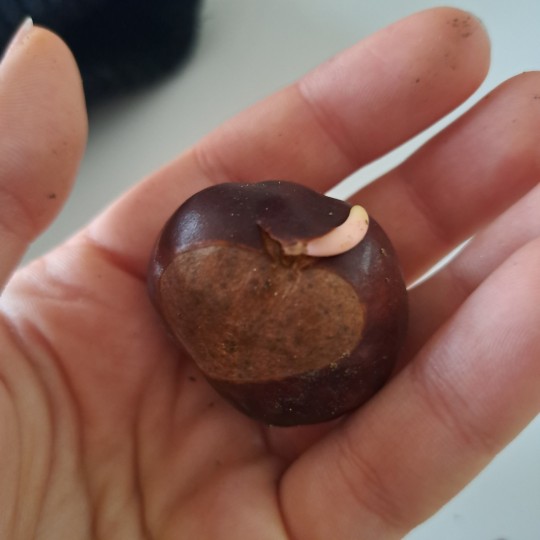
I would have gladly left it if I didn't know that they would be mowed down by the gardeners. I simply couldn't stand the thought, many of you might know that I'm like a pet rescue person but for plants.... I went to look for more and more I found!
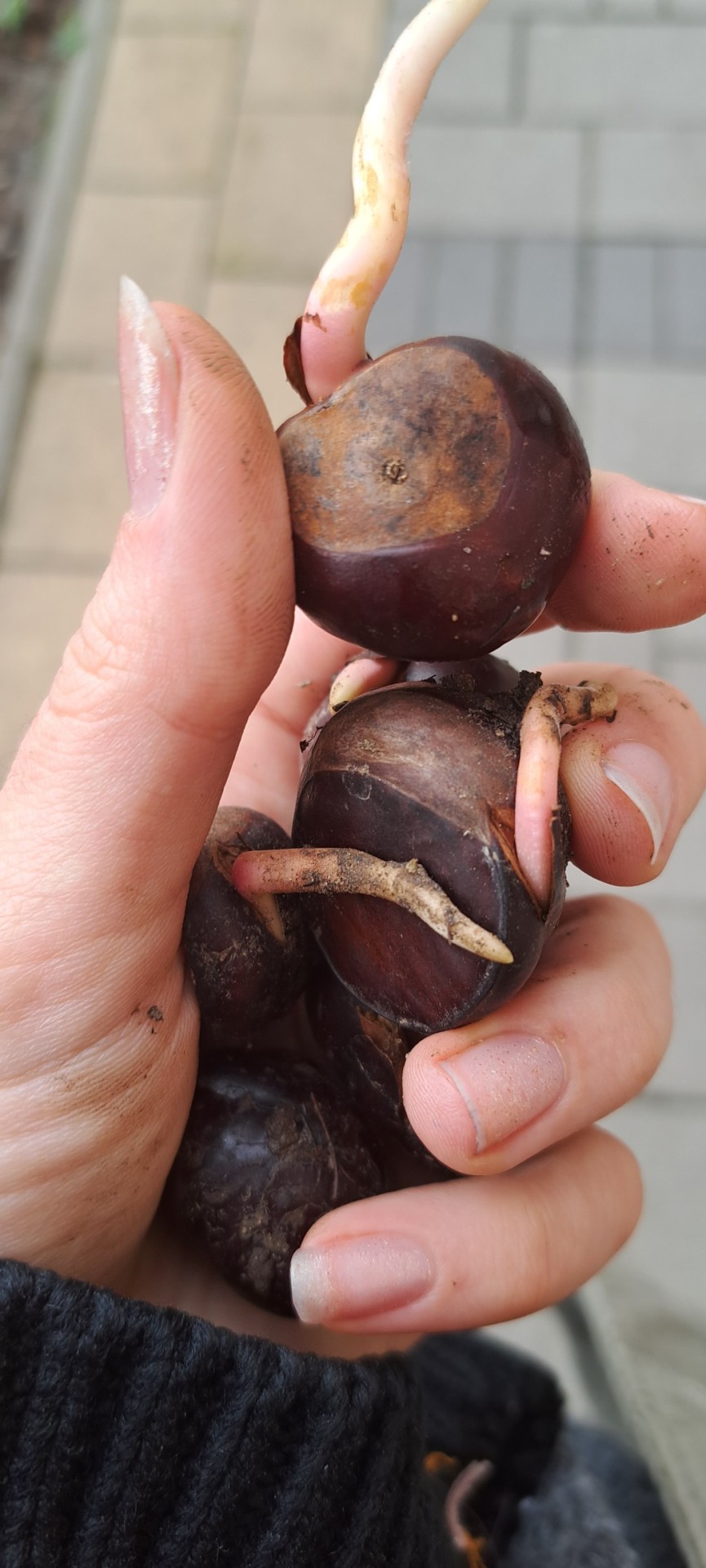
I had a few empty pots, so according to my best knowledge I chose a deep, dark brown one to put all the little babies in. Chestnut seedlings are quite sensitive, but I fucked up a bunch of times and they lived, so all you clumsy besties out there shouldn't worry too much!
I put them in sand mixed with garden soil and put a bunch of dry leaves on it as mulch. (Make sure you put leaves that are good for mulch, some leaves such as walnut leaves stunt germination) the pot being dark would make it warmer, thus making them grow quicker.

I knew some of them would probably not make it, so when they were big enough that I could tell which ones are strong, I put those in their own pots outside. They were put in very nutritious flower soil and I put pinebark mulch on them. It's not as insulating as leaves, but it helps retain moisture better and is less likely to be blown away by wind.
I didn't throw away the ones that I thought wouldn't make it, I kept them because I wanted to give them a chance. They staid in the warm nursery pot.
I found one that hadn't sprouted yet, when I was looking for seeds in January. It didn't grow a root in time, so I threw it in the compost with the definitely dead ones. I was building a raised garden bed with my father, and when we filled it with soil, we found the chestnut seed had sprouted in the compost. I immediately put it in a pot and placed it with the other ones.
At that point an unexpected frost had ravaged the garden and I was devastated, because all of them looked dead... But they lived, literally none of them froze dead!
I never counted them, but I had about 20 of them at the beginning. And now I have 11. That's 55% success! (I'm bad at math don't argue with me if I'm wrong I don't care)
When they first started to grow leaves I took them inside. It is not necessary to do that, but every plant grows quicker in warmth, so I thought it would benefit me. The ones who were the quickest immediately got themselves their own big pots and were left on a windowsill with pine leaves for mulch. They block wind, but not sunlight. (If you pick the right pine) Since it was cold out, they're still nowhere as large as the ones I took indoors, even though they started sprouting leaves weeks in advance.
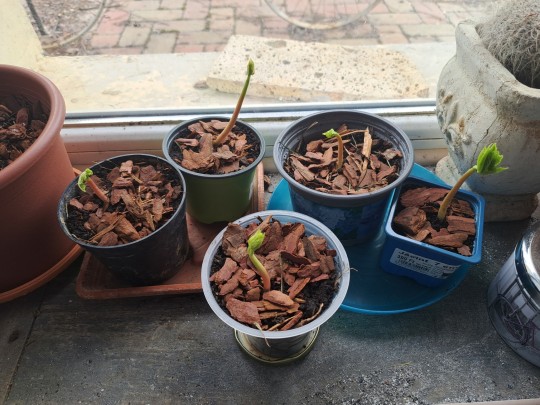

These are the ones I took in, they looked like this a week after I put them in their pots. The ones I left outside are not struggling, but they're still this small after two months of growing. Meanwhile the indoor ones grew their nursery pots out. I planted them in larger pots just last week. Only one of them looked to be doing worse off than the rest, but the only problem seemed to be a lack of root growth,(blue pot) which didn't stop it from having the most perfect and symmetrical leaves. I planted it in the big brown pot with one of its siblings because when their roots meet in the soil, they will help each other out.

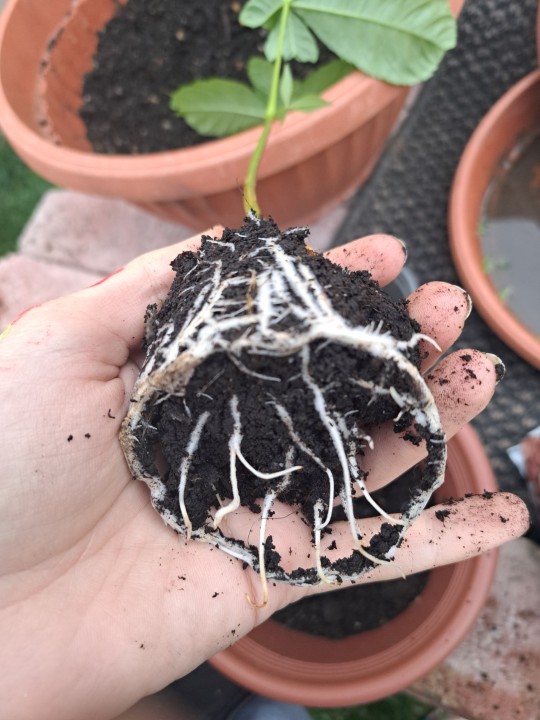
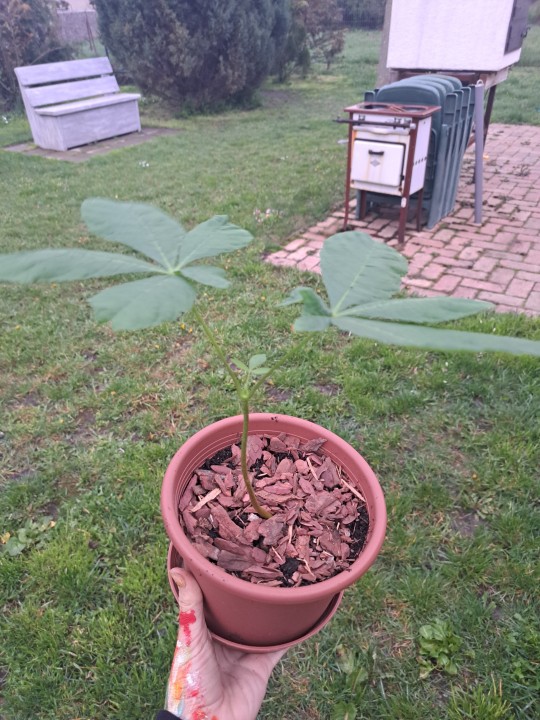
Next week, one of my friends will come and pick one of the chestnut children and take it home with. I feel really accomplished, but so saaaad! They grow up so fast, I'm going to cry! Aaah, my little babies....
That's about it for now, let's talk about why chestnut trees are the best!
They are drought resistant, they are one of the best carbon bonders that the average person can plant in their garden and they're outstandingly resistant to fungal infections! They look iconic, I can recognize a chestnut tree just by their branches alone~ They grow tall without much help from humans, since their branches and roots prefer to expand vertically as opposed to just going all over the place. They like sunlight a lot, so they have full canopies that give great shade in the summer. Unfortunately their leaves aren't the best compost, but that minor inconvenience is dwarves by all the amazing things this plant can do.
Their wood is strong and rot resistant, so it can be used for all sorts of crafts.
Bye besties, that's all the knowledge I'll be dropping on you today!
(Get chestnuts, now.)
9 notes
·
View notes
Text
7 Must-Have Indoor Plants for Home

Indoor plants not only add a touch of nature’s beauty to your home but also come with a plethora of benefits, from purifying the air to boosting your mood. If you’re looking to enhance your living space with some green companions, you’re in the right place.
Here I have came out with 9 best indoor plants for home that not only aesthetically pleasing but also easy to care for.
1. Snake Plant
Snake plants are among the best indoor plants for home environments due to their hardiness, air-purifying qualities, and minimal care requirements.
Botanical Name: Sansevieria trifasciata
Common Name: Snake Plant or Mother-in-law’s Tongue
How to Care for Snake Plants (Best Indoor Plants for Home)
Low Light Tolerance: Snake plants thrive in low light conditions, making them ideal for indoor spaces with limited sunlight.
Air Purification: Snake plants are excellent air purifiers, removing toxins like formaldehyde and xylene from the air, and enhancing indoor air quality.
Low Maintenance: They are low-maintenance and can tolerate neglect, making them perfect for busy households.
Well-Draining Soil: Plant snake plants in well-draining soil to prevent waterlogging, a common issue with indoor plants.
Moderate Temperatures: Snake plants prefer average room temperatures, making them adaptable to various home environments.
Occasional Fertilization: While they don’t need frequent feeding, a mild, balanced indoor plant fertilizer can be applied during the growing season for optimal growth.
Stylish Decor: Snake plants come in various sizes and shapes, adding a touch of elegance to your home decor.
Benefits of Snake Plant
Air Purification - Removes toxins like formaldehyde, xylene, toluene, and nitrogen oxides, improving indoor air quality.
Oxygen Production - Generates oxygen at night, enhancing sleep quality; perfect for bedrooms
Low Water Needs - Thrives with minimal water, ideal for busy individuals or forgetful watering schedules.
Feng Shui Benefits - Brings positive energy according to Feng Shui practices, making it popular for homes and offices
2. Polka Dot Plant (Hypoestes phyllostachya)
Polka dot is Known for its vibrant, spotted leaves, which add a splash of color to indoor spaces, making it one of the best indoor plants for home decor.
Botanical Name: Hypoestes phyllostachya
Common Name: Polka Dot Plant
How to Care for Polka Dot
Bright, Indirect Light: Place your Polka Dot Plant in a location with bright, indirect sunlight. It thrives indoors as a decorative plant.
Regular Watering: Keep the soil consistently moist. Water the plant when the top inch of soil feels dry, ensuring good drainage to prevent water stagnation.
3. Aloe vera

Aloe Vera’s attractive, spiky leaves make it a decorative addition to your home, enhancing the aesthetic of your indoor space. Apart from that it is one of several plants identified by NASA for its air-purifying abilities. It effectively removes toxins from the air, making it a natural air purifier for indoor spaces.
Botanical Name: Aloe barbadensis miller
Common Name: Aloe, Burn Plant, First Aid Plant
How to Care for Aloe Vera
Sunlight: Aloe vera thrives in bright, indirect sunlight. It can tolerate some direct sunlight, but too much intense sun can lead to sunburned leaves.
Well-Draining Soil: Plant aloe vera in a well-draining cactus or succulent potting mix.
Temperature: Aloe vera prefers warm temperatures between 59-77°F (15-25°C). It can withstand brief periods of colder or hotter temperatures but should be protected from frost.
Fertilizing: Aloe vera doesn’t need frequent fertilizing. You can feed it with a diluted, balanced liquid fertilizer every 4-6 weeks during the growing season (spring and summer).
Pruning: Remove dead or damaged leaves at the base using clean, sharp scissors or pruning shears. Regular pruning can encourage new growth and keep the plant looking tidy.
Why Aloe Vera is Ideal for home?
Medicinal Uses - Aloe Vera’s gel is widely recognized for its healing properties. It soothes burns, skin irritations, and minor wounds, making it a natural first-aid remedy.
Air Purification - Aloe Vera improves indoor air quality by absorbing harmful chemicals like formaldehyde and benzene, promoting a healthier living environment.
Low Maintenance - Aloe Vera is exceptionally low-maintenance, requiring minimal attention while thriving in diverse environmental conditions.
Decorative Appeal - Its striking rosette of fleshy leaves and minimalistic aesthetic add a touch of green elegance to any space, enhancing the overall decor.
4. String of hearts
String of Hearts is an excellent choice for indoor plants due to its charming appearance, easy care requirements, and the visual interest it brings to your living space.
Botanical Name: Ceropegia woodii
Common Name: String of Hearts
How to Care for String of Hearts:
Light: String of Hearts thrives in bright, indirect sunlight. It can tolerate some direct morning sun, but avoid intense afternoon sunlight, as it can scorch the delicate leaves.
Well-Draining Soil: Plant in well-draining cactus or succulent potting mix.
Temperature: String of Hearts prefers temperatures between 70-80°F (21-27°C). Protect it from cold drafts, as it’s sensitive to temperature drops.
Humidity: It can tolerate normal indoor humidity levels. However, it appreciates occasional misting, especially in drier environments.
5. Lavender
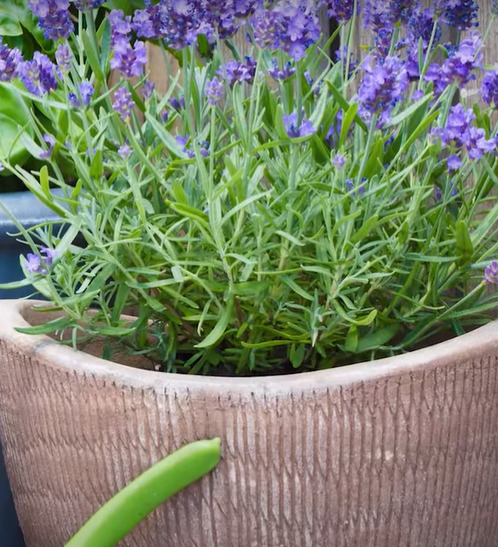
Lavender, a fragrant herb celebrated for its soothing aroma, isn’t just for gardens. This versatile plant can thrive indoors, adding a touch of elegancy to your home.
Best Indoor Plants for Home – Lavender
Botanical name– Bold Lavandula
Common Name– Bold Lavender
How to care for Lavender
Here are short and concise points on how to care for Lavender indoors-
Light: Provide bright, indirect sunlight for at least 6 hours daily.
Soil: Use well-draining soil mixed with sand or perlite.
Watering: Water sparingly, allowing the soil to dry out between waterings.
Pot: Choose a pot with drainage holes to prevent waterlogging.
Temperature: Lavender thrives in average room temperatures (60-70°F or 15-21°C).
Pruning: Trim after flowering to promote bushier growth.
Fertilization: Use a balanced, water-soluble fertilizer every 2-4 weeks during the growing season.
Pest Control: Watch for pests like aphids and treat them promptly.
What Makes Lavender an Ideal Choice for Indoor Gardening?
Lavender isn’t just a pretty plant; it’s a powerhouse of benefits that make it an ideal choice for indoor gardening
Versatile Uses - Lavender isn’t just visually appealing; it’s also used in various culinary dishes, essential oils, and herbal remedies.
Aromatic Fragrance - The sweet, floral scent of Lavender can naturally freshen up any room, creating a pleasant ambiance.
6. Asparagus Fern (Asparagus aethiopicus)
Botanical Name: Asparagus aethiopicus Common Name: Asparagus Fern
How to care for This Indoor Plant
Asparagus Fern is renowned for its hardiness, making it a favorite among both beginner and experienced gardeners. Here’s how you can ensure your Asparagus Fern bloom
1. Lighting Requirements: Asparagus Fern thrives in bright, indirect light. Avoid direct sunlight.
2. Watering: Keep the soil consistently moist but not waterlogged. Water thoroughly when the top inch of the soil feels dry to the touch.
3. Temperature and Humidity: Maintain a room temperature between 60-75°F (15-24°C). Asparagus Fern appreciates high humidity, so consider misting its leaves regularly.
4. Soil: Plant your Asparagus Fern in well-draining potting mix. Adding perlite or sand can enhance drainage.
5. Fertilization: During the growing season (spring and summer), feed your plant with a balanced liquid fertilizer every 4-6 weeks.
7. Ponytail Palm
Botanical Name: Beaucarnea Recurvata Common Name: Ponytail Palm or Elephant’s Foot Plan
Ponytail Palm is a unique and captivating plant that adds an exotic touch to any indoor space. Its distinct appearance and minimal care requirements make it a popular choice among plant enthusiasts.
How to Care for Ponytail Palm:
1. Sunlight: Ponytail Palms thrive in bright, indirect light. While they can tolerate some direct sunlight, too much sun exposure may lead to scorching.
2. Watering: These plants have a unique water storage system in their swollen trunk, allowing them to withstand drought. Water sparingly, allowing the top few inches of soil to dry out between waterings. Overwatering can lead to root rot.
3. Soil: Plant Ponytail Palms in well-draining cactus or succulent soil mix. Good drainage is essential to prevent waterlogged roots and maintain the plant’s health.
4. Temperature: Ponytail Palms prefer warm temperatures and are sensitive to cold. Protect them from drafts and ensure they are kept in a consistently warm environment, especially during winter.
5. Pruning: Minimal pruning is required. Remove dead or damaged leaves close to the trunk using clean, sharp scissors to maintain the plant’s appearance.
Indoor Plants and Their Positive Impact on Mental Health
Interacting with plants triggers the release of endorphins, reducing stress, anxiety, and promoting a sense of well-being.
Studies show that the presence of indoor plants can lower cortisol levels, leading to reduced stress and increased relaxation.
Indoor greenery has been linked to improved concentration, memory, and overall brain function, enhancing productivity.
Plants release moisture during transpiration, increasing indoor humidity and reducing dry skin and respiratory problems.
Studies indicate that people surrounded by greenery report higher life satisfaction and a more positive outlook.
Different plants have different care requirements, so pick ones that suit your lifestyle and home environment. Caring for indoor plants can indeed be a rewarding yet challenging task. To make it easier, consider these factors like light conditions, humidity, and your own level of gardening expertise.
If you found this list of the best indoor plants for home helpful, why not take the next step? Explore our other articles for more tips on indoor plants for home, home decor, gardening, and lifestyle. Have a question or a specific topic in mind? Feel free to ask.
2 notes
·
View notes